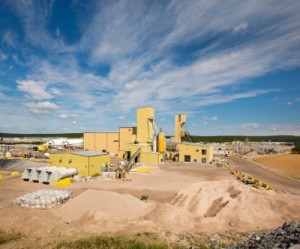The Saskatoon, Saskatchewan-based miner expects to start mining this summer and the first packaged pounds of uranium from the massive Cigar Lake project is expected before the end of year.
According to Cameco its 50%-owned Cigar Lake (France’s Areva holds 37%) is the world’s second largest high-grade uranium deposit (Cameco’s McArthur Lake being the largest) boasting U3O8 grades 100 times the global average.
Cigar Lake is a truly gigantic project with full annual production of 18 million pounds expected to be achieved in 2018.
Mining will be through an innovative non-entry method using a jet boring system – which involves using water under high pressure to carve out cavities in the orebody and then collecting the resulting ore slurry through pipes – that will be deployed within access tunnels being developed about 25 metres beneath the orebody.
The Cigar Lake orebody is being frozen prior to mining to improve ground conditions, prevent water inflow and improve radiation protection . Only 250 people are required to work the mine.

Another allbeit much smaller project went into production a couple of weeks ago – the company’s North Butte mine in Wyoming is expected to contribute 300,000 pounds in 2013 and ramp up to more than 700,000 pounds per year by 2015.
The uranium market has been under huge pressure since the earthquake and tsunami that struck Japan in March 2011, crippling the Fukushima Dai-Ichi nuclear power plant and prompting many nations to curtail nuclear power.
Uranium spot price fell this week to $39.75 U3O8, plunging below $40.00 for the first time since March 2006 and well below the $66.50 prior to Japanese catastrophe.
In May Cameco posted a dramatic first quarter profit drop of 93% as uranium sales fell and prices continued to soften.
Cameco said it produced 5.9 million pounds of uranium during the quarter and sold 5.1 million pounds. A year earlier, it had output of 4.8 million pounds and sales of 8.2 million pounds.